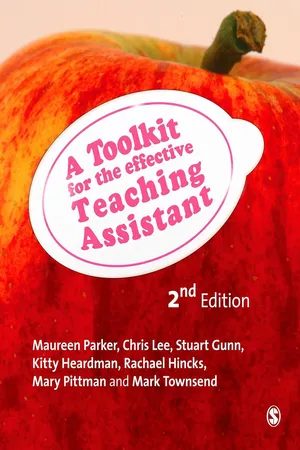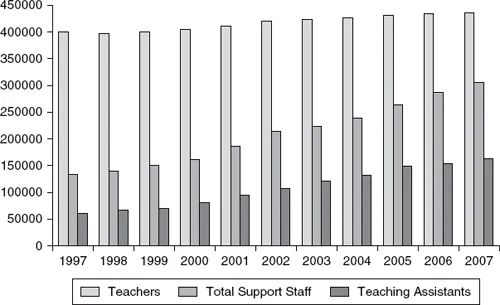![]()
SECTION 1
ROLES, RESPONSIBILITIES AND RELATIONSHIPS
![]()
1 | CHANGING SCHOOLS, CHANGING ROLES FOR TEACHING ASSISTANTS |
Mark Townsend and Maureen Parker |
This chapter will:
- Document and explain the phenomenal increase in the number of Teaching Assistants (TAs) and Higher Level Teaching Assistants (HLTAS) in schools.
- Explore the increasingly diverse roles of support staff.
- Define and explore the notion of the TA as the ‘new professional’ in the classroom.
The traditional classroom, staffed by a single teacher, is rapidly disappearing in schools across the UK. (Wilson et al., 2003)
RE-DEFINING THE ROLE OF THE TEACHING ASSISTANT IN A CLIMATE OF CHANGE
It is an exciting time to be a TA or HLTA. The role is evolving rapidly with its own dynamic structures and emerging professional identity. Indeed, if you have been working in schools over the past 10 years you will have seen the impact of a raft of initiatives, driven mostly by central government policy-making departments, and overseen by the Department for Children, Schools and Families. How schools have responded to this wave of change, varies widely, and will largely depend on those factors which underpin change and leadership described in Chapters 2 and 3. Nowhere are these changes more clearly exemplified than in the increase in numbers of school support staff, and in the responsibilities for teaching and learning that many of these staff have now acquired. Indeed, as Ofsted (2007) reports, there has been a ‘revolutionary shift in the culture of the school workforce’ resulting from school workforce reform. The number of support staff working in schools in England has more than doubled within 10 years (Blatchford et al., 2006), and the Training and Development Agency for Schools (TDA, 2008) recorded, by early 2008, over 21,000 Teaching Assistants gaining Higher Level Teaching Assistant Status (HLTA), a new educational role only introduced in 2002.
Let’s return to the TDA’s definition of the roles of the TA and HLTA, highlighted in the introduction:
Teaching assistants work alongside teachers in the classroom, helping pupils with their learning on an individual or group basis. Some specialise in areas such as literacy, numeracy, special education needs, music, English as an additional language, and the creative arts.
Higher level teaching assistants (HLTAs) are experienced teaching assistants who plan and deliver learning activities under the direction of a teacher and assess, record and report on pupils’ progress. They may also manage other classroom-based staff or may supervise a class in a teacher’s absence. (http://www.tda.gov.uk/support/support_staff_roles/learningsupportstaff.aspx (accessed 14 August 2008))
Whilst statistics and definitions clearly exist that describe the range of roles that TAs/HLTAs have, an actual understanding of effective support in the classroom is more difficult to achieve than one might anticipate. Research findings question the fundamental belief that providing additional educators in the classroom will always guarantee greater levels of achievement for pupils (Blatchford, 2003; Muijis and Reynolds, 2003; Peddar, 2006). However, Blatchford et al. (2006) certainly report on the positive factors, cited by many teachers, that TAs bring to the classroom: reduced workloads, lowered levels of stress, shared engagement in planning, and the benefits that additional one staffing brings to the delivery of intervention strategies. Our work with TAs/HLTAs suggests that an extra dimension is certainly added to schools where roles are clearly defined and understood for TAs/HLTAs and teachers.
ALL CHANGE: NEW POLICIES, NEW PRACTICES
The current government were, in part, elected because of their commitment to education. As the then Prime Minister Tony Blair is famously quoted as saying one of his top priorities for the country was ‘education, education, education’. Indeed, since 1945 central government has become increasingly involved in directing what goes on in schools and how schools themselves should be organised. It can also be argued that since 1978 all successive governments have had two key objectives in mind: to raise educational standards in terms of measuring quantifiable learning outcomes, and to allow marketplace economics to be the main vehicle for driving up those standards. In other words, governments would instigate frameworks which allowed all to see the results and performance of schools, and, importantly, enable parents to make highly informed decisions about which school they wanted their children to attend. With the role of overseeing in great detail and reporting on the performance of all schools, would be the regulatory body, Ofsted giving detailed curriculum guidance, including that offered by the Qualifications and Curriculum Authority for those pupils with severe and complex learning difficulties (as exemplified by the ‘P-scales’). The year 1997 was also a key date for a government focus upon ‘inclusion’ rather than integration, with an accompanying increase in support staff to begin to facilitate this process.
HLTA Standards 14, 16, 19, 20 & 31
Changes made to the education system during the last 10 years include the consolidation of summative assessment processes, the revision of core curriculum frameworks, the extended schools initiative, workforce reforms, and perhaps most significantly of all, the introduction of the Every Child Matters agenda in 2004 and the Children’s Plan in 2008. Perhaps almost of equal importance, in terms of impacting especially on the role of the HLTA, has been the introduction of statutory Planning, Preparation and Assessment (PPA) time for teachers. This has encouraged many schools to formally employ HLTAs (and sometimes TAs) in the role of leading the teaching of whole classes, without the direct supervision of a teacher – although the content and delivery of the lesson will have been planned under the guidance of the appropriate teacher. For many support staff, this is a very significant development of their role.
WHY ARE TAs CONSIDERED FUNDAMENTAL TO THE IMPLEMENTATION OF THE GOVERNMENT’S VISION FOR SCHOOLS?
If the government is going to succeed in its vision for achieving a world class education system (Balls, 2008), there may yet need to be more changes to the way schools are currently organised and the roles and responsibilities of the adults in them. You, as a TA, may certainly have noted that the days of the ‘traditional’ classroom staffed by one adult (the teacher) who is responsible for delivering all aspects of teaching and learning are almost over. Townsend and Parker (2006, 2007) reported that schools have developed the role of the TA, and especially the HLTA in very different ways to begin to address the need for change in both the opportunity for management roles for TAs and how they are managed.
Wilson et al.’s extensive 2007 report found that just over half of all schools had developed a specific role for HLTAs. To that effect HLTAs are integral to helping to achieve the current Every Child Matters (DfEs, 2004) agenda which focuses on developing an ‘integrated approach’ for all those in agencies working for the welfare of children. The latest initiative, the Children’s Plan, announced in 2008, will drive forward ideas on improving partnerships with parents, and build on both the Extended Schools and the Inclusion agendas.
The government certainly believes that increasing the number of support staff in the classroom will help to impact on children’s academic achievement (Blair, 2005), and overall performance of pupils in Standard Assessment Tests (SATs) has, by the indicators set by the DfES, certainly been raised as the role of TAs has become one of increasing direct teaching and learning suppport. However, the direct correlation between educator numbers and effective raising of pupil achievement is a complex and under-researched area (Vincett et al., 2005).
In terms of contributing generally towards helping schools meet the demands of these government strategies, the TA role and can be defined, according to the TDA (date unknown, accessed 12 July 2008) in terms of providing effective practice as one which:
- seeks to enable pupils to become more independent learners
- fosters the participation of pupils in the academic and social processes of the school
- helps to raise standards of learning for pupils.
DRIVING FORCES FOR CHANGE
In Chapter 3, Chris Lee discusses the importance of identifying ‘drivers of change’, and how an understanding of these ‘drivers’ can help us to manage changes. Indeed, it is evident from well-documented research that the educational landscape is shifting with increasing rapidity (Blatchford, 2003; Townsend and Parker, 2006; Wilson et al., 2003). Whilst it is always impossible to categorically isolate reasons for change – whether it happens as a result of deliberate interventions, or is a reflection of wider issues in society at large – there are clearly several pieces of government legislation which are affecting the roles of TAs. Workforce reform has been the prime factor, which the government saw as being fundamental to implementing its future education policies.
The Workforce Reform Agenda
HLTA Standards 17, 18 30 & 31
Driven initially by the Green Paper of 1998, Teachers: Meeting the Challenge of Change (DfEE, 1998) and the subsequent Workforce Reform Agenda (of 2003), teachers have seen several key aspects of their roles transferred to support staff. Apart from moving the responsibilities of some 25 routine tasks from teacher to TA as part of the School Workforce Reform Agenda (Teachernet, 2003), the provision of planning, preparation and assessment (PPA) time for all teachers in English primary schools has involved most TAs in a greater level of responsibility for teaching and learning than could have been predicted even 10 years ago. Indeed, there are many TAs (primarily HLTAs) now who are teaching whole classes under the direction or supervision of a teacher, leading small groups of pupils in ‘catch-up’ sessions, assisting teachers with their planning and preparation, and even taking on subject coordination roles including that of the role of Assistant SENCO in many primary schools. As a result of workforce reform, Ofsted (2007) believes that there has been a ‘revolutionary shift in the culture of the school workforce’. They also report that:
- Teacher’s time and work are now focused more directly on teaching and learning.
- The substantial expansion of the wider workforce at all levels is allowing schools to extend the curriculum, provide more care, guidance and support for pupils, and monitor children’s progress more effectively.
Pupils benefited from increased support from members of the wider workforce. In addition, deploying adults with different skills allowed the schools to improve care and guidance for vulnerable pupils and those at risk from exclusion from mainstream education, thus meeting the government’s drive for inclusion of all pupils through the development of the Common Assessment Framework (2006) and latterly, the Children’s Plan which ‘aims to make [England] the best place in the world for our children and young people to grow up’ (Balls, 2008).
Figure 1.1 School workforce trends (DfES, 2007)
The increase in the number of teaching assistants (full-time equivalent positions) in England has been phenomenal, rising from approximately 60,000 in 1997 to nearly 163,000 in 2007. Figure 1.1 illustrates the consistent growth which has taken place in the school workforce (now referred to as the Children’s Workforce) over the past 10 years.
As stated earlier in this chapter, the TDA has also recorded over 21,000 TAs gaining Higher Level Teaching Assistant Status (HLTA). Those with HLTA status will have demonstrated that can meet 33 newly revised Standards (January 2008) (Appendix 2), including providing evidence that they can teach whole classes as well as small groups of pupils, under the direction of a qualified teacher. These sta...

